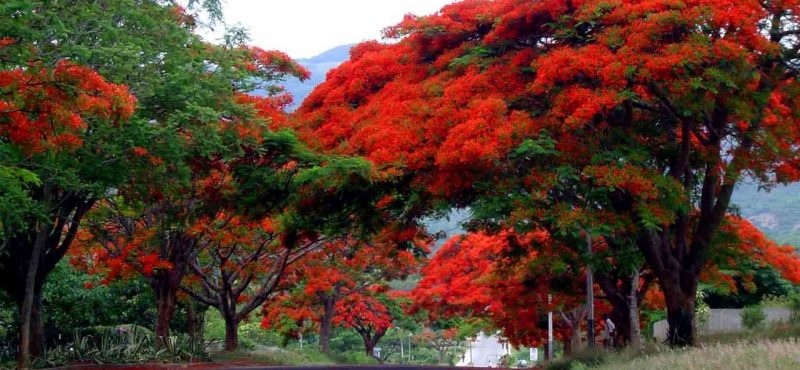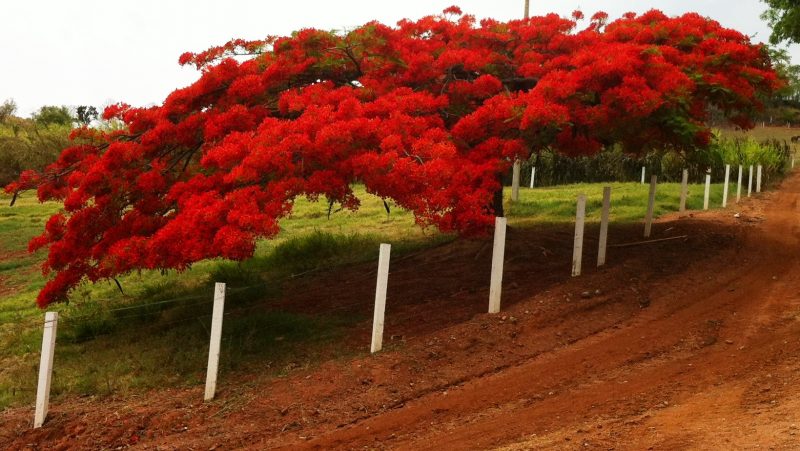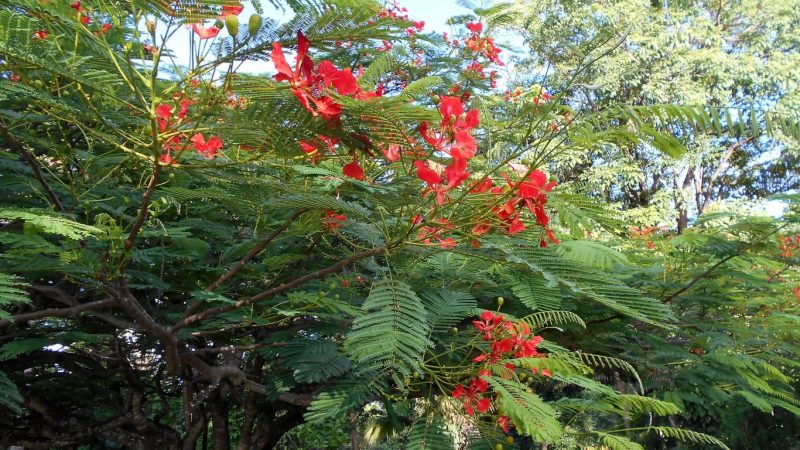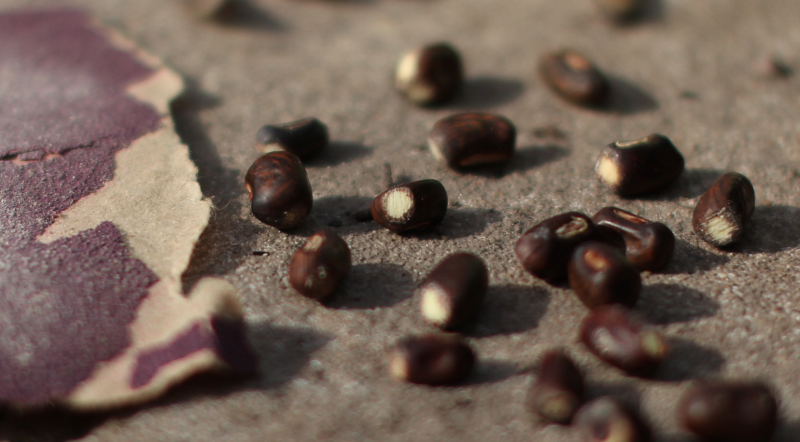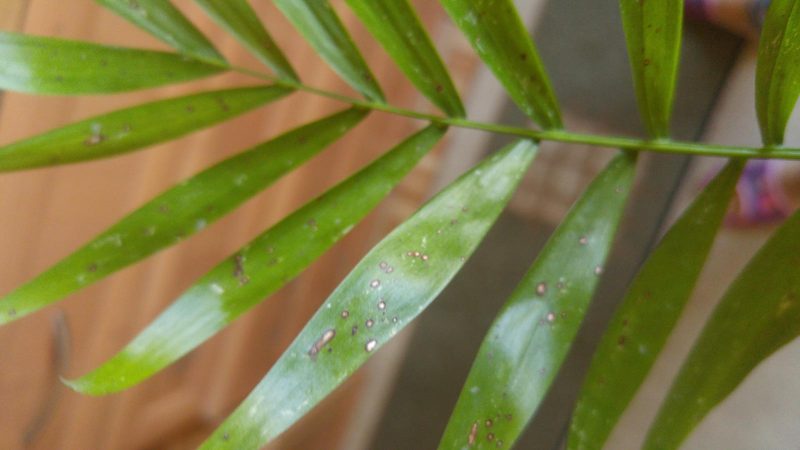Royal Delonix is one of the most beautiful plants on the planet, famous for its bright flowering, during which the crown burns with red shades. This was the reason for the origin of another unofficial name “Fire Tree”. It is possible to grow it in indoor conditions, which is not easy, but if desired, it is quite possible.
Material Content:
General description of the plant
Delonix Royal - deciduous tree of the legume family, characterized by:
- Powerful rooted roots growing from the trunk and giving the tree stability. They are so strong that they break through the asphalt and destroy nearby buildings.
- A tall (10–20 cm) trunk covered with smooth bark, changing color from light to brown with dark spots as it grows. Each year, the trunk grows 3 m higher, reaching its maximum size by 3-4 years.
- A sprawling crown with a diameter equal to the height of the trunk, during flowering, turning into a huge fiery umbrella.
- An unusual form of long (up to 50-60 cm) bright green double-ply, short-leaved leaves resembling ferns. They grow in August after flowering, and every evening they fold and wilt.
However, delonix gained worldwide fame thanks to its unrivaled flowering beauty.
In the spring, before the leaves appear, on the delonix branches a huge number of large (up to 10 cm) buds are formed, collected in apical or axillary racemose inflorescences of bright red, scarlet or orange shades.Each flower is formed by five petals with uneven edges and bases, sharply tapering to the center. Four of them are identical in shape and shade, the fifth has the appearance of a sail and is colored with light specks or peculiar strokes. The central part of the bud is decorated with a pestle with a dozen velvety, long and yellow-red stamens bent upwards.
The flowering period is 2–2.5 months. In place of pollinated buds, fruits rapidly growing in size develop - flat pods about 4 cm wide and up to 60 cm long, changing color from green to dark purple, brown or black. Inside the fruit are 20-30 seeds, 2-3 cm long, covered with a hard dark shell.
Where does the "fire tree" grow
The homeland of Delonix is Madagascar. From this island, the seeds of the Fire Tree were brought to Japan, China, India, Northern Australia, and then to Africa and the Caribbean Islands.
Royal Delonix grows in areas with a tropical and subtropical climate, eliminating the presence of minimum subzero temperatures. This condition determines the area of its growth.
In Russia, the plant is not cultivated under the open sky, but if desired, a small copy of it can be grown bonsai or like a regular indoor flower.
Growing Delonix at home
A tree propagates by seed. The process of growing adult plants from seeds is distinguished by the duration and need for meticulous implementation of all recommendations for caring for plants during the first 2-3 years.
Ground and pot requirements
The plant is planted in volumetric pots having a good compartment for drainage and openings for water drainage. In spacious rooms, conservatories and greenhouses grown in tubs.
A fire tree is not demanding on the composition of the soil, but it is important for it that the earth is light and loose, freely pass air and moisture. These properties are possessed by a mixture of leaf and turf soil (2 parts each) with the addition of coarse river sand or small (3-5 cm) pebbles (1 part).
The plant is not demanding on soil acidity, but does not like strong alkalization.
Preparing and planting seeds
Delonix seeds are covered with a very dense shell, so they germinate for a long time.
To speed up the process before planting, they are subjected to processing by one of the following methods:
- for 2–3 min, they are placed in boiling water, then it is diluted with cold liquid so that they can endure the hands, and left for a day without additional heating;
- pierce or file the seed coat with a sharp object (awl, thick needle, needle file), and then incubate for a day in a solution of a drug that stimulates tissue growth (Zircon, Epin).
Planting is carried out in small containers filled with a wet mixture of sand and turf soil (1: 1), peat and vermiculite (1: 1). By the appearance of the seed, it is difficult to determine the place where the sprout and roots emerge; therefore, the seeds are placed horizontally and sprinkled with 2-3 mm of soil.
The surface of the container is covered with a transparent airtight material, simulating a greenhouse with an air temperature of at least 27 ° C. After a day, the seedlings are aired. When the topsoil dries, it is slightly moistened.
Under optimal conditions, sprouts will appear in 1–1.5 months. Slow germination is replaced by a rapid (10-15 cm per month) process.
Rules for the care of sprouts and adult trees
An important point in growing Delonix from seeds is the care of seedlings.
They are so gentle and weak that they can die from direct sunlight or slight overflow.
For this reason, young plants:
- placed in partial shade or darken from direct sunlight;
- moderately watered, guided by the state of the upper layer of soil: it should always be slightly moist. The plant reacts to a lack of moisture by dropping leaves and looks unattractive until it grows;
The first flowering will have to wait 3.5-4 years.As a reward for work and patience in room conditions, Delonix blooms for a month longer than its "street" counterparts.
Caring for an adult plant is less burdensome and consists in the proper placement, watering, feeding, transplants, pruning and organization of the rest period:
- From spring to autumn, the flower is placed in a warm (20–25 degrees) and bright place - on the windowsills of the south or south-west windows. In the summer they take out into the open air.
- During flowering (from May to September), delonix is rarely watered, allowing the topsoil to completely dry to a depth of 2-3 cm. During the growth of leaves, watering is increased.
- From March to September, room copies feed. Before flowering, mineral additives for decorative deciduous plants are introduced, from the moment the first buds appear, fertilizers for decorative flowering forms. Top dressing is combined with irrigation using solutions in concentrations recommended by the manufacturer.
- Young (up to 3 years) plants are transplanted annually, changing the capacity to a more capacious one. Adults - as the entire volume of the pot is filled with roots. In very large specimens, they are limited to an annual change in the upper (2-3 cm) soil layer.
- In spring, the plant shortens the main shoot. In autumn, after flowering, pruning forms a crown, giving it the desired look. The fire tree painlessly transfers these procedures.
After autumn pruning, the flower is forcibly sent to rest.
For this:
- move to a cooler (10–12 ° C) place;
- stop feeding;
- reduce watering, allowing drying of the entire earthen coma.
The flower will react to the cessation of hydration by yellowing and dropping of foliage. After 2-3 months, watering is gradually resumed, which will lead to an increase in lateral shoots and the formation of buds.
The longer the flower rests, the more abundant and brighter will be its flowering.
Pests and diseases
A fire tree is resistant to disease and infrequently attacked by pests.
In isolated cases, with violations of the growing conditions, lesions by the scab and spider mites are possible:
- Scale shield develops with a lack of sunlight. The insect settles on shoots and leaves, forming small dense dark tubercles or plaques. If pests are detected, they are cleaned by hand with a soft cloth dipped in a concentrated solution of laundry soap. In case of severe damage, they are repeatedly treated with insecticides (Intavir, Fitoverm, Aktara) according to the instructions for the drug.
- If the flower is kept for a long time in a poorly ventilated room with dry air, a spider mite may appear, which settles on the underside of the leaves, forming a coating of gray or brownish tint. With a severe lesion between the shoots and leaves, a thin cobweb is visible. The insect is disposed of by treating the ground with a soapy solution. Before the event, the soil is covered with waterproof material. After 1.5–2 weeks, the composition is washed off under a warm shower. If there is no result, the plant is repeatedly treated, with a weekly interval, with acaricides (Antiklesch, Fufanon, Sanmayt). The room where the flower is located is regularly ventilated and all measures are taken to increase air humidity.
It is interesting:fufanon
Patience and competent care will certainly give a positive result - Royal Delonix will surprise everyone around with its unusual and spectacular flowering every year.


